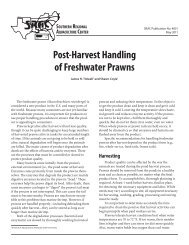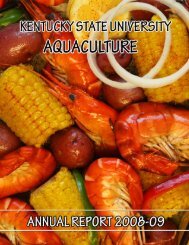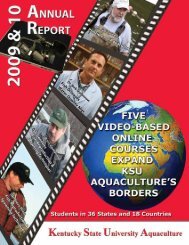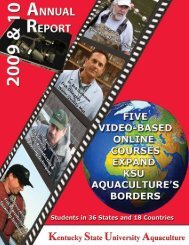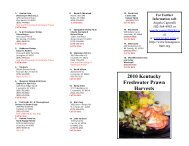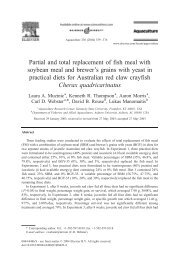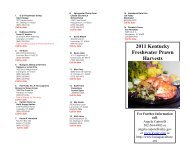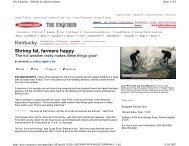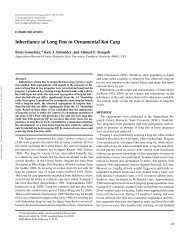Evaluation of practical diets containing different protein levels, with ...
Evaluation of practical diets containing different protein levels, with ...
Evaluation of practical diets containing different protein levels, with ...
Create successful ePaper yourself
Turn your PDF publications into a flip-book with our unique Google optimized e-Paper software.
Aquaculture 244 (2005) 241–249<br />
www.elsevier.com/locate/aqua-online<br />
<strong>Evaluation</strong> <strong>of</strong> <strong>practical</strong> <strong>diets</strong> <strong>containing</strong> <strong>different</strong> <strong>protein</strong> <strong>levels</strong>,<br />
<strong>with</strong> or <strong>with</strong>out fish meal, for juvenile Australian red claw crayfish<br />
(Cherax quadricarinatus)<br />
Kenneth R. Thompson, Laura A. Muzinic, Linda S. Engler, Carl D. Webster*<br />
Aquaculture Research Center, Kentucky State University, Frankfort, KY 40601, USA<br />
Received 30 August 2004; received in revised form 2 November 2004; accepted 8 November 2004<br />
Abstract<br />
Six <strong>practical</strong> <strong>diets</strong> <strong>containing</strong> increasing percentages <strong>of</strong> crude <strong>protein</strong> (CP) (30%, 35%, and 40%) <strong>with</strong> or <strong>with</strong>out anchovy<br />
fish meal (FM) were fed to juvenile red claw crayfish (mean individual weight=1.12 g) during an 8-week feeding trial. Growth,<br />
survival, feed conversion ratio, and amino acid composition <strong>of</strong> tail-muscle meat <strong>of</strong> juvenile red claw were determined.<br />
At the conclusion <strong>of</strong> the experiment, specific growth rate (SGR) and percent survival among treatments, which averaged<br />
3.91%/day and 80.7%, overall, were not significantly <strong>different</strong> among treatments. The percent weight gain <strong>of</strong> red claw fed a diet<br />
<strong>containing</strong> 20% fish meal and 40% crude <strong>protein</strong> was significantly higher (1352%) than that <strong>of</strong> red claw fed a diet <strong>containing</strong><br />
0% fish meal and 30% crude <strong>protein</strong> (828%), but not <strong>different</strong> from red claw fed all other <strong>diets</strong>. Red claw fed Diet 3 had<br />
significantly higher FCR (5.73) compared to red claw fed Diet 6 (3.03) but not <strong>different</strong> from red claw fed the other four <strong>diets</strong>.<br />
Results from this study indicate that juvenile red claw can be fed a <strong>practical</strong> diet <strong>containing</strong> 35% CP <strong>with</strong> 0% FM if a<br />
combination <strong>of</strong> less expensive plant <strong>protein</strong> ingredients (SBM, wheat, BGY, and milo) is added. CP <strong>levels</strong> can be reduced to<br />
30% if 15% anchovy fish meal is included. Reducing CP <strong>levels</strong> and the reliance <strong>of</strong> fish meal in Australian red claw <strong>diets</strong> may<br />
help reduce operating costs and thereby increase producers pr<strong>of</strong>its.<br />
D 2004 Elsevier B.V. All rights reserved.<br />
Keywords: Red claw crayfish; Cherax quadricarinatus; Protein level; Fish meal; Diet<br />
1. Introduction<br />
Currently, the Australian red claw crayfish is being<br />
considered an aquaculture species in the United States<br />
* Corresponding author. Tel.: +1 502 597 8109; fax: +1 502<br />
597 8118.<br />
E-mail address: cwebster@dcr.net (C.D. Webster).<br />
and is commercially cultured in several countries,<br />
including Mexico and Australia. Research results have<br />
shown that red claw possess many biological and<br />
market prerequisites necessary to achieve successful<br />
culture. Red claw are fed inexpensive <strong>diets</strong> and grow<br />
rapidly (65–90 g) in a limited (117 days) growing<br />
season in temperate climate ponds (Thompson et al.,<br />
2004). They possess flexible eating habits, are highly<br />
0044-8486/$ - see front matter D 2004 Elsevier B.V. All rights reserved.<br />
doi:10.1016/j.aquaculture.2004.11.018
242<br />
K.R. Thompson et al. / Aquaculture 244 (2005) 241–249<br />
marketable because they resemble marine lobsters, are<br />
generally nonaggressive in nature, and can command<br />
a high price ($13–17 per kg) in an established market.<br />
Further, there is no post-hatch larval phase, thereby<br />
precluding the requirement for larval culture as found<br />
for other crustacean species (Jones, 1995). Currently,<br />
the red claw commercial enterprise in the US is very<br />
small principally because hatchery-grown stock are<br />
not readily available. Growers must purchase stocking-size<br />
individuals from hatcheries in other countries<br />
(Australia or Mexico) and cost can range from $0.40–<br />
0.50 per juvenile. Recent efforts have been directed to<br />
determine specific nutrient requirements and evaluate<br />
inexpensive <strong>practical</strong> <strong>diets</strong> to help reduce production<br />
costs and possibly increase pr<strong>of</strong>its (Jacinto et al.,<br />
2003; Thompson et al., 2003a,b, 2004; Muzinic et al.,<br />
2004).<br />
Protein is generally the most expensive component<br />
in a prepared diet for aquaculture. Lim (1997) stated<br />
that <strong>protein</strong> is the most critical ingredient in <strong>practical</strong><br />
shrimp <strong>diets</strong> based upon cost and growth response. As<br />
<strong>protein</strong> <strong>levels</strong> influence diet costs, and diet costs can<br />
represent up to 70% <strong>of</strong> the total operating costs <strong>of</strong> an<br />
aquaculture enterprise, it is imperative that <strong>diets</strong><br />
<strong>containing</strong> <strong>different</strong> percentages <strong>of</strong> <strong>protein</strong> be evaluated<br />
to determine the minimal level that meets<br />
essential amino acid requirements and contribute to<br />
maximum growth. Jacinto et al. (2003) reported that a<br />
<strong>practical</strong> diet <strong>containing</strong> 31% crude <strong>protein</strong> (CP)<br />
seems adequate for 1 g juvenile red claw, while<br />
Webster et al. (1994) reported that newly hatched<br />
(mean weight=0.022 g) red claw required 33% CP.<br />
However, both <strong>of</strong> these studies were conducted in<br />
aquaria, where the red claw were grown communally,<br />
and may have had access to supplemental nutrients<br />
when mortalities occurred in the culture system. To<br />
determine the <strong>protein</strong> requirement for red claw,<br />
individual culture units are needed to eliminate the<br />
possibility <strong>of</strong> the organism obtaining additional<br />
nutrients.<br />
Fish meal (FM) is considered the most desirable<br />
animal <strong>protein</strong> ingredient in nutritionally complete<br />
<strong>diets</strong> for fish and crustaceans due to its high <strong>protein</strong><br />
content and digestibility, serving as an excellent<br />
source <strong>of</strong> essential fatty acids and energy, and its<br />
high palatability. As FM is one <strong>of</strong> the most expensive<br />
macro-ingredients (used in high percentages) in an<br />
aquaculture diet, proportional reductions <strong>of</strong> FM in<br />
aquaculture <strong>diets</strong> is a current major research priority.<br />
Fish meal prices have risen and are likely to increase<br />
further <strong>with</strong> continued growth in demand. The<br />
response has been a steady rise in cost and an intense<br />
focus on finding substitutes. Naylor et al. (2000)<br />
stated that farm-raised fish fed FM also has produced<br />
negative publicity from the detection <strong>of</strong> industrial<br />
pollutants (PCBs and dioxin) that create the perception<br />
that aquaculture is not ecologically sound. Longterm<br />
availability <strong>of</strong> FM in the future is questionable.<br />
Thus, formulations <strong>of</strong> production <strong>diets</strong> will need to<br />
partially, or totally, reduce the percentages <strong>of</strong> FM<br />
<strong>with</strong>out adversely affecting the growth and health <strong>of</strong><br />
the cultured aquaculture species.<br />
As red claw are omnivorous, they may be able to<br />
utilize substitutes for FM such as plant-based <strong>protein</strong><br />
sources (soybean meal) and thus reduce or eliminate<br />
dietary FM. Xue et al. (1999) reported that red claw<br />
have the enzyme polysaccharide hydrolase which<br />
enables them to digest plant material readily.<br />
Replacement <strong>of</strong> FM <strong>with</strong> less expensive ingredients,<br />
such as soybean meal (SBM), may contribute to a<br />
reduction in diet costs. In a recent study, Muzinic et<br />
al. (2004) reported that FM and shrimp meal could<br />
be completely replaced by soybean meal (SBM) and<br />
brewer’s grains <strong>with</strong> yeast (BGY) in <strong>diets</strong> fed to<br />
juvenile red claw <strong>with</strong>out adverse effects on growth<br />
and survival.<br />
Currently, information about specific nutritional<br />
requirements and <strong>practical</strong> diet formulations for red<br />
claw has increased (Jacinto et al., 2003; Thompson et<br />
al., 2003a,b, 2004; Muzinic et al., 2004). Webster et<br />
al. (1994) stated that formulation <strong>of</strong> <strong>diets</strong> for intensive<br />
culture requires an understanding <strong>of</strong> nutritional<br />
requirements, and lack <strong>of</strong> such information may<br />
impede red claw aquaculture in the United States. In<br />
the absence <strong>of</strong> a commercially-available diet formulated<br />
specifically for red claw, producers may elect to<br />
use expensive high-quality, commercial shrimp <strong>diets</strong>,<br />
a decision that is probably a financial and nutritional<br />
waste. Another approach would be the use <strong>of</strong> lowquality<br />
<strong>diets</strong> that do not completely meet nutrient<br />
requirements <strong>of</strong> the species and thereby may reduce<br />
growth, health, and survival.<br />
The objective <strong>of</strong> this study was to evaluate the<br />
effects <strong>of</strong> <strong>practical</strong> <strong>diets</strong> <strong>containing</strong> increasing percentages<br />
<strong>of</strong> crude <strong>protein</strong> (CP) (30%, 35%, and 40%),<br />
<strong>with</strong> or <strong>with</strong>out anchovy fish meal (FM), on growth,
K.R. Thompson et al. / Aquaculture 244 (2005) 241–249 243<br />
survival, feed conversion ratio, and amino acid<br />
composition <strong>of</strong> tail muscle meat <strong>of</strong> juvenile red claw.<br />
2. Materials and methods<br />
2.1. Experimental <strong>diets</strong><br />
Six <strong>practical</strong> <strong>diets</strong> were formulated to contain<br />
increasing percentages <strong>of</strong> <strong>protein</strong> (30%, 35%, and<br />
40%) (as fed basis) <strong>with</strong> or <strong>with</strong>out anchovy fish meal<br />
(FM) based upon tabular values <strong>of</strong> <strong>protein</strong> content <strong>of</strong><br />
ingredients (Lovell, 1998). Practical <strong>diets</strong> were<br />
formulated to contain the same ratio <strong>of</strong> <strong>protein</strong>/added<br />
lipid (5.7) and marine fish oil/corn oil ratio (2.5),<br />
respectively. The ingredient compositions <strong>of</strong> the <strong>diets</strong><br />
are presented in Table 1. Diet 1 contained 30% CP<br />
<strong>with</strong> 0% FM and 42.5% SBM; Diet 2 contained 30%<br />
CP <strong>with</strong> 15% FM and 20% SBM; Diet 3 contained<br />
35% CP <strong>with</strong> 0% FM and 56.5% SBM; Diet 4<br />
contained 35% CP <strong>with</strong> 17.5% FM and 30.5% SBM;<br />
Diets 5 contained 40% CP <strong>with</strong> 0% FM and 71%<br />
SBM; and Diet 6 contained 40% CP <strong>with</strong> 20% FM<br />
and 40.5% SBM, and its ingredient composition was<br />
similar to a high-quality marine shrimp diet.<br />
2.2. Preparation <strong>of</strong> <strong>diets</strong><br />
Dry ingredients were weighed (Mettler PM 4600,<br />
Mettler Instrument, Hightstown, NJ), combined, and<br />
mixed together thoroughly for 1 h using a Hobart<br />
mixer (A-200 T; Hobart, Troy, OH). Warm tap water<br />
was then added to obtain a 25% moisture level. Diets<br />
were single extruded through a 1-cm die to form<br />
bspaghetti-likeQ strands and air-dried in a convection<br />
oven (Grieve, Round Lake, IL). After drying, all <strong>diets</strong><br />
were broken into pellets <strong>of</strong> appropriate size using a<br />
Disk Mill (S.500; GlenMills, Clifton, NJ) and then<br />
sieved (2-mm opening mesh) using a USA standard<br />
testing sieve (Fisher Scientific, Pittsburgh, PA). After<br />
sieving, a combination <strong>of</strong> sardine oil and corn oil that<br />
had previously been mixed together were slowly<br />
added to the diet and mixed until all pellets were<br />
uniformly coated. The oils were added after pelletizing<br />
to avoid destruction <strong>of</strong> essential fatty acids<br />
(HUFAs) during processing (Thompson et al.,<br />
2003a,b). Diets were stored in plastic containers at<br />
20 8C until fed.<br />
Table 1<br />
Ingredient composition <strong>of</strong> the six <strong>practical</strong> <strong>diets</strong> <strong>containing</strong> three<br />
<strong>different</strong> <strong>protein</strong> <strong>levels</strong> (30%, 35%, and 40%) <strong>with</strong> or <strong>with</strong>out fish<br />
meal fed to red claw crayfish<br />
Ingredient Diets<br />
1<br />
(30%)<br />
2.3. Diet analysis<br />
2<br />
(30%)<br />
3<br />
(35%)<br />
4<br />
(35%)<br />
5<br />
(40%)<br />
6<br />
(40%)<br />
Anchovy fish 0.0 15.0 0.0 17.5 0.0 20.0<br />
meal (65%)<br />
Soybean 42.5 20.0 56.5 30.5 71.0 40.5<br />
meal (48%)<br />
Wheat<br />
20.0 20.0 20.0 20.0 8.8 20.0<br />
flour (12.5%)<br />
Milo (11.5%) 19.05 28.05 4.17 14.42 0.0 1.3<br />
BGY (35%) a 5.0 5.0 5.0 5.0 5.0 5.0<br />
Sardine oil 3.75 2.25 4.38 2.63 5.0 3.0<br />
Corn oil 1.5 1.5 1.75 1.75 2.0 2.0<br />
Vitamin mix b 2.0 2.0 2.0 2.0 2.0 2.0<br />
Mineral mix c 0.5 0.5 0.5 0.5 0.5 0.5<br />
Vitamin C 0.2 0.2 0.2 0.2 0.2 0.2<br />
(35% active) d<br />
Dicalcium 1.0 1.0 1.0 1.0 1.0 1.0<br />
phosphate<br />
Choline chloride 0.5 0.5 0.5 0.5 0.5 0.5<br />
Wheat gluten 4.0 4.0 4.0 4.0 4.0 4.0<br />
(80%)<br />
Protein/added 5.71 5.71 5.71 5.71 5.71 5.71<br />
lipid ratio<br />
Marine fish 2.5 2.5 2.5 2.5 2.5 2.5<br />
oil /corn oil<br />
Values are percentages <strong>of</strong> the diet.<br />
a BGY-35 (F.L. Emmert, Cincinnati, OH).<br />
b Vitamin mix was the Abernathy vitamin premix no. 2 and<br />
supplied the following (mg or IU/kg <strong>of</strong> diet): biotin, 0.60 mg; B 12 ,<br />
0.06 mg; E (as alpha-tocopheryl acetate), 50 IU; folic acid, 16.5 mg;<br />
myo-inositol, 132 mg; K (as menadione sodium bisulfate complex),<br />
9.2 mg; niacin, 221 mg; pantothenic acid, 106 mg; B 6 , 31 mg;<br />
rib<strong>of</strong>lavin, 53 mg; thiamin, 43 mg; D 3 , 440 IU; A (as vitamin A<br />
palmitate), 4399 IU; ethoxyquin, 99 mg.<br />
c Mineral mix was Rangen trace mineral mix F1 for catfish <strong>with</strong><br />
0.3 mg selenium/kg diet added.<br />
d Vitamin C (Roche’s Stay C at 35% active).<br />
The composition <strong>of</strong> each <strong>of</strong> the experimental <strong>diets</strong><br />
was analyzed to determine percent moisture, <strong>protein</strong>,<br />
lipid, fiber, and ash. Moisture was determined by<br />
placement <strong>of</strong> a 2-g sample into a convection oven<br />
(135 8C) for 2 h until constant weight (Association <strong>of</strong><br />
Official Analytical Chemists [AOAC], 1990, procedure<br />
930.15); <strong>protein</strong> was determined by combustion<br />
(AOAC, 1990, procedure 990.03); lipid was deter-
244<br />
K.R. Thompson et al. / Aquaculture 244 (2005) 241–249<br />
Table 2<br />
Results <strong>of</strong> proximate analysis <strong>of</strong> six <strong>practical</strong> <strong>diets</strong> <strong>containing</strong> three<br />
<strong>different</strong> <strong>protein</strong> <strong>levels</strong> (30%, 35%, and 40%) <strong>with</strong> or <strong>with</strong>out fish<br />
meal fed to red claw crayfish<br />
Diets<br />
1<br />
(30%)<br />
2<br />
(30%)<br />
3<br />
(35%)<br />
4<br />
(35%)<br />
5<br />
(40%)<br />
6<br />
(40%)<br />
Moisture (%) 9.9 10.8 11.8 9.7 12.1 10.1<br />
Crude <strong>protein</strong> (%) a 35.32 35.56 40.50 40.99 45.24 46.07<br />
Crude lipid (%) a 9.53 8.98 10.81 10.00 11.83 10.62<br />
Fiber (%) a 2.22 2.02 2.38 2.10 2.84 2.00<br />
Ash (%) a 5.89 7.17 6.70 8.15 7.61 9.09<br />
NFE b 47.04 46.27 39.61 38.76 32.48 32.22<br />
Values are means <strong>of</strong> two replications per diet.<br />
a Dry-matter basis.<br />
b NFE=nitrogen-free extract (by difference).<br />
mined by the acid hydrolysis method (AOAC, 1990,<br />
procedure 954.02); fiber was determined by using the<br />
fritted-glass crucible method (AOAC, 1990, procedure<br />
962.09); and ash was determined by placing a 2-<br />
g sample in a muffle furnace (600 8C) for 2 h<br />
(AOAC, 1990, procedure 942.05). The nitrogen-free<br />
extract (NFE) was determined by difference<br />
[NFE=100 (% <strong>protein</strong>+% lipid+% fiber+% ash)].<br />
Available energy (AE) was calculated from physiological<br />
fuel values <strong>of</strong> 4.0, 4.0, and 9.0 kcal/g for<br />
<strong>protein</strong>, carbohydrate (NFE), and lipid, respectively<br />
(Garling and Wilson, 1977; Webster et al., 1999).<br />
Proximate composition <strong>of</strong> each <strong>of</strong> the six <strong>practical</strong><br />
<strong>diets</strong> are presented in Table 2, and amino acid<br />
compositions are presented in Table 3. Proximate<br />
and amino acid composition was determined by a<br />
commercial analytical laboratory (Eur<strong>of</strong>ins Scientific,<br />
Des Moines, IA).<br />
2.4. Experimental system and maintenance<br />
A feeding trial was conducted using 150 plasticmesh<br />
culture units (12.7 cm 3 ; Plastic Window<br />
Breeder-Fine, Lustar Products, Springfield, NJ)<br />
located <strong>with</strong>in five rectangular fiberglass tanks<br />
(325.5-l; 23610215 cm) at the Aquaculture<br />
Research Center, Kentucky State University. Dechlorinated<br />
city (tap) water was recirculated through a<br />
2000-l biological and mechanical filtration system<br />
<strong>containing</strong> vertical polyester screens and polyethylene<br />
bio-balls (Red Ewald, Karnes City, TX) and then<br />
passed through a propeller washed bead filter (Aquaculture<br />
Systems Technologies, New Orleans, LA) to<br />
remove solid and nitrogenous wastes and provide<br />
substrate for nitrifying bacteria. Each culture unit was<br />
equipped <strong>with</strong> an individual water tube connected to a<br />
Table 3<br />
Amino acid composition <strong>of</strong> six <strong>practical</strong> <strong>diets</strong> <strong>containing</strong> three <strong>different</strong> <strong>protein</strong> <strong>levels</strong> (30%, 35%, and 40%) <strong>with</strong> or <strong>with</strong>out fish meal fed to red<br />
claw crayfish<br />
Amino acid Diets<br />
1 (30%) 2 (30%) 3 (35%) 4 (35%) 5 (40%) 6 (40%)<br />
Alanine 1.43 (4.05) 1.62 (4.56) 1.52 (3.75) 1.89 (4.61) 1.76 (3.89) 2.04 (4.43)<br />
Arginine 1.98 (5.61) 1.91 (5.37) 2.36 (5.83) 2.11 (5.15) 2.47 (5.46) 2.44 (5.30)<br />
Aspartic acid 3.33 (9.43) 3.12 (8.77) 3.91 (9.65) 3.75 (9.15) 4.46 (9.86) 4.32 (9.38)<br />
Cystine 0.53 (1.50) 0.45 (1.27) 0.66 (1.63) 0.63 (1.54) 0.72 (1.59) 0.68 (1.48)<br />
Glutamic acid 7.45 (21.09) 7.06 (19.85) 7.92 (19.56) 8.16 (19.91) 8.45 (18.68) 8.63 (18.73)<br />
Glycine 1.44 (4.08) 1.63 (4.58) 1.64 (4.05) 1.97 (4.81) 1.86 (4.11) 2.19 (4.75)<br />
Histidine 0.78 (2.21) 0.78 (2.19) 0.90 (2.22) 0.89 (2.17) 0.98 (2.17) 1.01 (2.19)<br />
Isoleucine 1.31 (3.71) 1.31 (3.68) 1.48 (3.65) 1.50 (3.66) 1.64 (3.63) 1.69 (3.67)<br />
Leucine 2.47 (6.99) 2.49 (7.00) 2.69 (6.64) 2.84 (6.93) 3.03 (6.70) 3.08 (6.69)<br />
Lysine 1.54 (4.36) 1.66 (4.67) 1.89 (4.67) 1.98 (4.83) 2.14 (4.73) 2.31 (5.01)<br />
Methionine 0.47 (1.33) 0.60 (1.69) 0.55 (1.36) 0.77 (1.88) 0.59 (1.30) 0.83 (1.80)<br />
Phenylalanine 1.58 (4.47) 1.50 (4.22) 1.77 (4.37) 1.75 (4.27) 1.99 (4.40) 1.93 (4.19)<br />
Proline 2.21 (6.26) 2.15 (6.05) 2.28 (5.63) 2.54 (6.20) 2.47 (5.46) 2.62 (5.69)<br />
Serine 1.65 (4.67) 1.56 (4.39) 1.88 (4.64) 1.89 (4.61) 2.15 (4.75) 2.08 (4.51)<br />
Threonine 1.30 (3.68) 1.35 (3.80) 1.49 (3.68) 1.64 (4.00) 1.73 (3.82) 1.83 (3.97)<br />
Tyrosine 1.02 (2.89) 1.01 (2.84) 1.16 (2.86) 1.19 (2.90) 1.32 (2.92) 1.35 (2.93)<br />
Valine 1.46 (4.13) 1.50 (4.22) 1.64 (4.05) 1.73 (4.22) 1.84 (4.07) 1.95 (4.23)<br />
Values are percentage <strong>of</strong> the diet. Values in parentheses are expressed as percentage <strong>of</strong> dietary <strong>protein</strong>.
K.R. Thompson et al. / Aquaculture 244 (2005) 241–249 245<br />
plastic aquarium pipe valve that supplied water at a<br />
rate <strong>of</strong> 0.8 l/min. Each culture unit contained a 5-cm<br />
section <strong>of</strong> 1-in. diameter PVC pipe for shelter. Water<br />
temperature was maintained at 27–29 8C by the use <strong>of</strong><br />
an immersion heater located in the biological and<br />
mechanical filtration system, and continuous aeration<br />
was provided through air diffuser tubing inside each<br />
fiberglass tank.<br />
Approximately 5% <strong>of</strong> the total water volume was<br />
replaced daily <strong>with</strong> dechlorinated city (tap) water.<br />
Lighting was provided by overhead fluorescent<br />
ceiling lights on a 12:12-L/D cycle. Sodium bicarbonate<br />
and crushed coral were added in the recirculating<br />
system to maintain alkalinity <strong>levels</strong> near 100<br />
mg/l. Each culture unit was cleaned every other day<br />
to remove uneaten diet and feces; molts were not<br />
removed.<br />
Water quality parameters were checked three<br />
times weekly. Dissolved oxygen was measured using<br />
a YSI Model 58 oxygen meter (YSI Industries,<br />
Yellow Springs, OH); water temperature was measured<br />
using a thermometer; total ammonia and nitrite<br />
were determined using a DREL/2000 spectrophotometer<br />
(HACH, Loveland, CO); pH was determined<br />
<strong>with</strong> an electronic pH meter (pH pen; Fisher<br />
Scientific, Cincinnati, OH); and total alkalinity and<br />
chlorides were determined using a digital titrator<br />
(HACH).<br />
2.5. Stocking and feeding<br />
Juvenile red claw (Cherax quadricarinatus) averaging<br />
1.12F0.77 g (S.D.), produced from a single<br />
female, were obtained from Auburn University,<br />
Auburn, AL, and individually and randomly stocked<br />
into 150 plastic-mesh culture units <strong>with</strong>in the five<br />
rectangular tanks at 25 culture units per treatment. A<br />
tank was randomly selected, and an individual red<br />
claw was then stocked into a randomly selected<br />
culture unit <strong>with</strong>in that tank. This process was<br />
continued until all red claw were stocked. After<br />
stocking, one <strong>of</strong> the six experimental <strong>diets</strong> was<br />
randomly chosen for each culture unit. During the<br />
first week after stocking, any mortalities were<br />
replaced <strong>with</strong> an individual <strong>of</strong> similar weight. Thereafter,<br />
no mortalities were replaced.<br />
Red claw were fed one <strong>of</strong> six <strong>practical</strong> <strong>diets</strong><br />
formulated to contain increasing percentages <strong>of</strong><br />
<strong>protein</strong> (30%, 35%, and 40%), <strong>with</strong> or <strong>with</strong>out FM,<br />
and fed three times daily (800, 1200, and 1500 h) to<br />
bcontrolled excessQ based on the observation <strong>of</strong> the<br />
amount <strong>of</strong> uneaten diet for 8 weeks.<br />
2.6. Data collection<br />
At the conclusion <strong>of</strong> the feeding trial, each red claw<br />
was individually weighed on an electronic scale<br />
(AB54-S; Mettler Toledo, Columbus, OH). Growth<br />
parameters and feed efficiency were calculated as<br />
follows: SGR (%/day)=[(ln W t ln W i )/T ]100,<br />
where W t and W i are the final and initial individual<br />
weights <strong>of</strong> the red claw, respectively, and T is the<br />
length <strong>of</strong> the culture period in days; weight gain<br />
(%)=100[(W t W i )/W i ]; feed conversion ratio=total<br />
diet fed (kg)/total wet weight gain (kg).<br />
After weighing, all experimental red claw <strong>with</strong>in<br />
each treatment were chill-killed using an ice-water<br />
bath, the tail muscle was then removed from each<br />
body and stored frozen in ZiplockR bags until<br />
analyzed. There were two replicate samples <strong>of</strong><br />
pooled tail-muscle samples per treatment. Amino<br />
acid analysis was conducted (wet-weight basis) by a<br />
commercial analytical laboratory (Eur<strong>of</strong>ins Scientific,<br />
Memphis, TN). The essential amino acid index<br />
(EAAI) was then determined. This method compares<br />
the essential amino acid composition <strong>of</strong> each<br />
<strong>of</strong> the experimental <strong>diets</strong> to those in the tail muscle.<br />
EAAI provides a method to determine if the<br />
organism is obtaining adequate <strong>levels</strong> <strong>of</strong> essential<br />
amino acids.<br />
2.7. Statistical analysis<br />
Data were calculated for percent weight gain,<br />
specific growth rate (SGR), percent survival, feed<br />
conversion ratio (FCR), and essential amino acid<br />
index (EAAI).<br />
Data were analyzed according to a 32 factorial<br />
design using the SAS General Linear Models (GLM)<br />
procedure (SAS s<strong>of</strong>tware version 8.2; SAS, 1999)<br />
for significant differences among treatment means<br />
when analyzed by <strong>protein</strong> level, fish meal level, and<br />
their interaction. Duncan’s multiple range test was<br />
used to compare differences among individual means<br />
at the P=0.05 level <strong>of</strong> significance. A Chi-squared<br />
test was used to determine if survival was independ-
246<br />
K.R. Thompson et al. / Aquaculture 244 (2005) 241–249<br />
ent <strong>of</strong> diet type. All percentage and ratio data were<br />
transformed to arc sine values prior to statistical<br />
analysis (Zar, 1984).<br />
3. Results<br />
During the study, water quality parameters averaged<br />
(FS.D.): water temperature, 28.1F7.1 8C; dissolved<br />
oxygen, 6.9F0.3 mg/l; total ammonia nitrogen,<br />
0.34F0.08 mg/l; nitrite, 0.002F0.004 mg/l; total<br />
alkalinity, 108F38.7 mg/l; chloride, 77.1F64.7 mg/l;<br />
pH, 7.58F0.29. These water quality averages were<br />
<strong>with</strong>in acceptable limits for indoor production <strong>of</strong> red<br />
claw (Masser and Rouse, 1997).<br />
Proximate composition (which includes percent<br />
moisture, <strong>protein</strong>, lipid, fiber, and ash) and NFE <strong>of</strong><br />
the six <strong>practical</strong> <strong>diets</strong> are presented in Table 2, and<br />
amino acid composition <strong>of</strong> the <strong>diets</strong> are presented in<br />
Table 3.<br />
Initial weight did not differ significantly among<br />
treatments ( PN0.05). After 8 weeks, specific growth<br />
rate (SGR) and percent survival did not differ<br />
significantly among treatments, averaging 3.91%/<br />
day and 80.7%, respectively (Table 4). The percent<br />
weight gain <strong>of</strong> red claw fed Diet 6 was significantly<br />
higher (1352%) compared to that <strong>of</strong> red claw fed<br />
Diet 1 <strong>containing</strong> 0% FM and 30% <strong>protein</strong> (828%)<br />
but not <strong>different</strong> from those <strong>of</strong> red claw fed all<br />
other <strong>diets</strong>. Thus, red claw fed <strong>diets</strong> <strong>with</strong>out fish<br />
meal <strong>with</strong> <strong>protein</strong> <strong>levels</strong> lower than 35% had a<br />
reduced percent weight gain. Red claw fed Diet 3<br />
(0% FM and 35% <strong>protein</strong>) had a significantly<br />
higher FCR (5.73) compared to that <strong>of</strong> red claw<br />
fed Diet 6 (3.03), but not <strong>different</strong> from those <strong>of</strong><br />
red claw fed the other four <strong>diets</strong>.<br />
When analyzing data among the three <strong>protein</strong><br />
<strong>levels</strong> (30%, 35%, and 40%), which includes <strong>with</strong><br />
and <strong>with</strong>out FM, there were no significant differences<br />
for percent weight gain, SGR, and percent survival<br />
among treatments. The response values averaged<br />
1016%, 3.91, and 80.7%, respectively.<br />
Percent weight gain, SGR, and percent survival <strong>of</strong><br />
red claw fed <strong>diets</strong> <strong>containing</strong> FM were not significantly<br />
<strong>different</strong> compared to those <strong>of</strong> red claw fed<br />
<strong>diets</strong> <strong>containing</strong> no FM. Mean values <strong>of</strong> these<br />
responses were 1012%, 3.91, and 80.7%, respectively.<br />
Mean (FS.E.) essential amino acid composition<br />
<strong>of</strong> the tail-muscle meat <strong>of</strong> red claw and EAAI results<br />
for each <strong>of</strong> the dietary treatments are presented in<br />
Table 5. Red claw fed Diet 2 had significantly higher<br />
percentage <strong>of</strong> methionine (0.42%) compared to that<br />
<strong>of</strong> red claw fed Diet 5 (0.32%), but not <strong>different</strong><br />
( PN0.05) from red claw fed all other treatments. All<br />
other analyzed amino acids were not significantly<br />
<strong>different</strong> ( PN0.05) among red claw fed the six <strong>diets</strong>.<br />
EAAI for <strong>diets</strong> in this study ranged from 176 to 185<br />
for red claw fed 30% <strong>protein</strong>, 208 to 212 for red<br />
claw fed 35% <strong>protein</strong>, and 237 to 254 for red claw<br />
fed 40% <strong>protein</strong> when compared to red claw tail<br />
muscle (Table 5). Elimination <strong>of</strong> fish meal <strong>with</strong><br />
increased soybean meal resulted in only modest<br />
change in the EAAI for each dietary <strong>protein</strong> level<br />
(30%, 35%, 40%).<br />
No significant differences in amino acid <strong>levels</strong><br />
were found among red claw fed the three <strong>protein</strong><br />
Table 4<br />
Mean (FS.E.) initial weight, percent weight gain, specific growth rate (SGR), feed conversion ratio (FCR), and percent survival <strong>of</strong> red claw<br />
crayfish fed three <strong>different</strong> <strong>protein</strong> <strong>levels</strong> (30%, 35%, and 40%) <strong>with</strong> or <strong>with</strong>out fish meal<br />
Diets<br />
1 (30%) 2 (30%) 3 (35%) 4 (35%) 5 (40%) 6 (40%)<br />
Initial wt. (g) 1.0F0.2 1.2F0.2 1.0F0.1 1.1F0.2 1.2F0.2 1.2F0.2<br />
Weight gain (%) 828F126 b 989F140 ab 919F118 ab 927F162 ab 1056F122 ab 1352F191 a<br />
SGR (%/day) 3.61F0.3 3.87F0.3 3.88F0.2 3.60F0.3 4.12F0.3 4.39F0.3<br />
FCR 4.69F0.2 ab 4.10F0.7 ab 5.73F1.2 a 4.81F0.6 ab 4.43F0.7 ab 3.03F0.4 b<br />
Survival (%)* 76.0 84.0 80.0 84.0 76.0 84.0<br />
Means having <strong>different</strong> superscripts <strong>with</strong>in a row are significantly <strong>different</strong> ( Pb0.05).<br />
* A Chi-squared test showed no significant difference ( PN0.05) in survival <strong>with</strong> respect to diet type (v 2 test statistic (TS)=1.2404; Critical<br />
value (CV) <strong>with</strong> 5 df=11.070).
K.R. Thompson et al. / Aquaculture 244 (2005) 241–249 247<br />
Table 5<br />
Essential amino acid composition (percentage <strong>of</strong> diet) and the essential amino acid index (EAAI) <strong>of</strong> the <strong>diets</strong> and essential amino acid<br />
composition <strong>of</strong> juvenile red claw tail muscle<br />
Amino acid Diets Muscle a<br />
1 (30%) 2 (30%) 3 (35%) 4 (35%) 5 (40%) 6 (40%)<br />
Arginine 1.98 1.91 2.36 2.11 2.47 2.44 1.45F0.09<br />
Histidine 0.78 0.78 0.90 0.89 0.98 1.01 0.35F0.02<br />
Isoleucine 1.31 1.31 1.48 1.50 1.64 1.69 0.68F0.04<br />
Leucine 2.47 2.49 2.69 2.84 3.03 3.08 1.18F0.07<br />
Lysine 1.54 1.66 1.89 1.98 2.14 2.31 1.23F0.07<br />
Methionine 0.47 0.60 0.55 0.77 0.59 0.83 0.36F0.02<br />
Phenylalanine 1.58 1.50 1.77 1.75 1.99 1.93 0.63F0.04<br />
Threonine 1.30 1.35 1.49 1.64 1.73 1.83 0.68F0.04<br />
Tyrosine 1.02 1.01 1.16 1.19 1.32 1.35 0.54F0.04<br />
Valine 1.46 1.50 1.64 1.73 1.84 1.95 0.70F0.04<br />
EAA index b<br />
Muscle 185.65 176.89 208.86 212.46 237.95 254.47<br />
a Means <strong>of</strong> two replications (FS.E.) for muscle tissue. Muscle values are presented for comparison and are not included in the statistical<br />
analysis. p<br />
b EAAI ¼<br />
ffiffiffiffiffiffiffiffiffiffiffiffiffiffiffiffiffiffiffiffiffiffiffiffiffiffiffiffiffiffiffiffiffiffiffiffiffiffiffiffiffiffiffiffiffiffiffiffiffiffiffiffiffiffiffiffiffiffiffiffiffiffiffiffiffiffiffiffiffiffi<br />
n<br />
½ðaa 1 =AA 1 Þðaa 2 =AA 2 Þ ... ðaa n = Aan ÞŠ, where EAAI is the nth root <strong>of</strong> the essential amino acids in the test diet (aa) to the content<br />
<strong>of</strong> each <strong>of</strong> those amino acids in the reference tissue (AA), and n is the total number <strong>of</strong> amino acids evaluated.<br />
<strong>levels</strong> (30%, 35%, and 40%) <strong>with</strong> and <strong>with</strong>out FM.<br />
No significant differences in amino acid <strong>levels</strong> were<br />
found among red claw fed <strong>diets</strong> <strong>containing</strong> FM<br />
relative to those <strong>of</strong> red claw fed <strong>diets</strong> <strong>containing</strong> no<br />
FM.<br />
4. Discussion<br />
The results <strong>of</strong> the present study indicate that<br />
juvenile red claw can be fed a <strong>practical</strong> diet <strong>with</strong> a<br />
combination <strong>of</strong> plant-<strong>protein</strong> ingredients and <strong>with</strong>out<br />
fish meal (FM) if the <strong>protein</strong> level is 35%; however, if<br />
the percentage <strong>of</strong> dietary <strong>protein</strong> is 30%, it appears<br />
that FM may be needed in the diet. These data are the<br />
first to indicate that the quantity and quality <strong>of</strong> <strong>protein</strong><br />
are important for growth <strong>of</strong> (1 g) juvenile red claw<br />
grown indoors. Muzinic et al. (2004) reported that<br />
juvenile (0.2–3.1 g) red claw can be fed a <strong>practical</strong><br />
diet in which all <strong>of</strong> the FM is replaced by 80%<br />
soybean meal (SBM) and 5% brewer’s grains <strong>with</strong><br />
yeast (BGY); however, that diet contained 40%<br />
<strong>protein</strong>.<br />
Webster et al. (1992) suggested that feeding <strong>of</strong><br />
<strong>diets</strong> <strong>containing</strong> a combination <strong>of</strong> <strong>protein</strong> sources<br />
may allow the use <strong>of</strong> a high percentage <strong>of</strong> SBM<br />
<strong>with</strong>out growth reduction. Inclusion <strong>of</strong> several highquality<br />
plant <strong>protein</strong> sources in the <strong>diets</strong> <strong>of</strong> our study<br />
may have sufficiently satisfied the requirements <strong>of</strong><br />
the essential amino acids. The <strong>levels</strong> <strong>of</strong> amino acids<br />
in the <strong>diets</strong> fed in the present study compare<br />
favorably to those in <strong>practical</strong> <strong>diets</strong> that have been<br />
successfully used in other studies <strong>with</strong> juvenile red<br />
claw (Thompson et al., 2003b; Muzinic et al., 2004).<br />
Results <strong>of</strong> the present study also suggest that <strong>levels</strong><br />
<strong>of</strong> dietary crude <strong>protein</strong> (CP) can be reduced to 30%<br />
if a level <strong>of</strong> 15% anchovy fish meal is included.<br />
Jacinto et al. (2003) reported that 1 g juvenile red<br />
claw, grown communally, required 31% dietary<br />
<strong>protein</strong> for optimal growth using a diet which<br />
contained 20% sardine meal. Webster et al. (1994)<br />
indicated that small (mean weight=0.022 g) juvenile<br />
red claw required 33% dietary <strong>protein</strong> (28% menhaden<br />
fish meal included) to achieve highest growth<br />
when grown communally in aquaria that were part <strong>of</strong><br />
an indoor recirculating system. Manomaitis (2001)<br />
evaluated <strong>protein</strong> requirement <strong>of</strong> two age classes <strong>of</strong><br />
juvenile red claw crayfish and reported that small<br />
(0.02 g) red claw required 40% dietary <strong>protein</strong>, while<br />
a diet <strong>containing</strong> 30% <strong>protein</strong> was sufficient for<br />
larger (3.0 g) red claw. All <strong>diets</strong> in the study<br />
contained high (N29%) <strong>levels</strong> <strong>of</strong> menhaden fish<br />
meal. In a recent study, Thompson et al. (2004)<br />
reported that red claw (4.6 g) could be fed a diet
248<br />
K.R. Thompson et al. / Aquaculture 244 (2005) 241–249<br />
<strong>containing</strong> 22% <strong>protein</strong> when grown in ponds,<br />
although the diet did contain some (7%) fish meal.<br />
It was suggested that natural food items in the pond<br />
may have satisfied part <strong>of</strong> the <strong>protein</strong> requirements<br />
<strong>of</strong> red claw, which are omnivorous detritivores.<br />
However, the possibility <strong>of</strong> red claw consuming<br />
additional nutrients in the present study appears<br />
minute, since they were grown in individual culture<br />
units in an indoor recirculating system.<br />
At present, the amino acid requirements <strong>of</strong> red<br />
claw have not been determined. Muzinic et al.<br />
(2004) have examined the amino acid composition<br />
<strong>of</strong> <strong>practical</strong> <strong>diets</strong> <strong>containing</strong> <strong>different</strong> <strong>levels</strong> <strong>of</strong> SBM<br />
and BGY, as replacements for FM, and results<br />
suggest that the amino acid <strong>levels</strong> in a 40% crude<br />
<strong>protein</strong> diet were adequate for good growth and<br />
survival <strong>of</strong> juvenile red claw crayfish. All <strong>diets</strong> fed<br />
to red claw in the present study had amino acid<br />
values similar to those in the Muzinic et al. (2004)<br />
study. These <strong>levels</strong> may have met or exceeded the<br />
animal’s requirements as indicated by the EAAI<br />
values. A complementary blend <strong>of</strong> soybean meal and<br />
other plant <strong>protein</strong> sources used to replace FM in a<br />
35% <strong>protein</strong> diet appear to provide sufficient <strong>levels</strong><br />
<strong>of</strong> essential amino acids to meet requirements. This<br />
observation is in agreement <strong>with</strong> the results obtained<br />
by Webster et al. (1992).<br />
Determination <strong>of</strong> the exact amino acid requirements<br />
in crustaceans is difficult (Shiau, 1998).<br />
Although a variety <strong>of</strong> methods have been used in<br />
previous feeding trials (Arai, 1981; Sick and<br />
Millikin, 1983), the essential amino acid index<br />
(EAAI), as proposed by Tacon and Cowey (1985),<br />
was used to compare the essential amino acid<br />
patterns <strong>with</strong>in the <strong>diets</strong> to those in the tail muscle.<br />
For each dietary <strong>protein</strong> level (30%, 35%, and<br />
40%), elimination <strong>of</strong> fish meal and a corresponding<br />
substitute <strong>with</strong> increased contents <strong>of</strong> soybean meal<br />
resulted in only modest change in the EAAI. For<br />
red claw fed <strong>diets</strong> <strong>containing</strong> 35% and 40% <strong>protein</strong>,<br />
the EAAI slightly decreased when fish meal was<br />
not included and soybean meal <strong>levels</strong> were<br />
increased. Based upon the EAAI index, red claw<br />
fed <strong>diets</strong> <strong>with</strong> no added FM may be obtaining<br />
adequate <strong>levels</strong> <strong>of</strong> essential amino acids. Results <strong>of</strong><br />
the present study are similar to those <strong>of</strong> Muzinic et<br />
al. (2004) who found that a decrease in the dietary<br />
content <strong>of</strong> fish meal <strong>with</strong> a corresponding substitution<br />
<strong>with</strong> soybean meal and BGY caused very little<br />
change in EAAI when <strong>diets</strong> were compared to red<br />
claw tail muscle.<br />
FCR values in the present study (3.03–5.73) were<br />
higher than previously reported values. Jacinto et al.<br />
(2003) reported that FCR values ranged from 1.04 to<br />
1.56 when red claw were grown communally. They<br />
stated that red claw were fed to apparent satiation<br />
twice daily at <strong>levels</strong> closely matching the maximum<br />
food ingested <strong>with</strong> little or no remaining food pellets.<br />
Manomaitis (2001) also reported FCR values that<br />
ranged from 1.14 to 1.61 for red claw grown<br />
individually in an indoor recirculating system. In that<br />
study, red claw were fed in the morning and evening,<br />
and feeding rates were based on the feeding response<br />
<strong>of</strong> each experimental crawfish. In the present study,<br />
red claw were fed pellets according to the observed<br />
level <strong>of</strong> feeding activity three times daily. However,<br />
while the amount <strong>of</strong> diet <strong>of</strong>fered was not too extreme,<br />
uneaten diet was present in the culture units and may<br />
explain why FCR values were higher in the present<br />
study. It is important to refrain from <strong>with</strong>holding food<br />
from organisms during a feeding trial, and overfeeding<br />
is more desirable than underfeeding (Tacon<br />
and Cowey, 1985). This is because underfeeding<br />
could result in suboptimal growth <strong>of</strong> the organism and<br />
lead to erroneous conclusions <strong>of</strong> diet suitability based<br />
upon the faulty growth data.<br />
Percent survival reflect results <strong>of</strong> other studies <strong>with</strong><br />
red claw. Survival ranged from 79–98% in Muzinic et<br />
al. (2004); Jacinto et al. (2003) reported survival <strong>of</strong><br />
65–89%; Thompson et al. (2003a) reported survival <strong>of</strong><br />
95–100%; Thompson et al. (2003b) reported survival<br />
<strong>of</strong> 56–80% for juvenile red claw fed experimental<br />
<strong>diets</strong>; and Webster et al. (1994) reported survival <strong>of</strong><br />
50–71%.<br />
The results <strong>of</strong> the present study indicate that<br />
juvenile red claw can be fed a diet <strong>with</strong> 30% CP<br />
when 15% fish meal is added; however, the removal<br />
<strong>of</strong> 15% fish meal requires a diet <strong>containing</strong> 35% CP<br />
when the ingredients in the present study are used.<br />
Reducing <strong>protein</strong> and fish meal <strong>levels</strong> and feeding a<br />
plant <strong>protein</strong>-based diet, which takes advantage <strong>of</strong><br />
their omnivorous feeding habits, may help reduce<br />
operating costs and thereby increase producer’s<br />
pr<strong>of</strong>its. Additional research devoted to the use <strong>of</strong><br />
plant <strong>protein</strong> ingredients to replace fish meal in <strong>diets</strong><br />
for crustacean species should be conducted.
K.R. Thompson et al. / Aquaculture 244 (2005) 241–249 249<br />
Acknowledgments<br />
The authors thank Tim Byrd (F.L. Emmert,<br />
Cincinnati, OH) for donation <strong>of</strong> BGY-35; Daniel H.<br />
Yancey, Robert T. Janes, B.R. Lee, M.S. Tee, D.R.<br />
Wynn, and Sam Wise for technical assistance,<br />
Michelle Coyle for typing this manuscript, and Len<br />
Rodgers (Auburn University, Auburn, AL) for providing<br />
the red claw juveniles. This research was<br />
partially funded by a USDA Capacity Building Grant,<br />
a grant from the Kentucky Soybean Promotion Board<br />
and Kentucky Soybean Association, and a USDA<br />
grant under agreement KYX-80-00-10A to Kentucky<br />
State University.<br />
References<br />
AOAC (Association <strong>of</strong> Official Analytical Chemists), 1990. Official<br />
Methods <strong>of</strong> Analysis, 15th ed. AOAC, Arlington, VA, USA.<br />
Arai, S., 1981. A purified test diet for coho salmon, Oncorhynchus<br />
kisutch, fry. Bull. Jpn. Soc. Sci. Fish. 47, 547–550.<br />
Garling, D.L., Wilson, R.P., 1977. Effect <strong>of</strong> dietary carbohydrate on<br />
growth and body composition <strong>of</strong> fingerling channel catfish.<br />
Prog. Fish-Cult. 39, 43–47.<br />
Jacinto, E.C., Colmenares, H.V., Cerecedo, R.C., Cordova, R.M.,<br />
2003. Effect <strong>of</strong> dietary <strong>protein</strong> level on growth and survival <strong>of</strong><br />
juvenile freshwater crayfish Cherax quadricarinatus (Decapoda:<br />
Parastacidae). Aquacult. Nutr. 9, 207–213.<br />
Jones, C.M., 1995. Production <strong>of</strong> juvenile redclaw crayfish, Cherax<br />
quadricarinatus (von Martens) (Decapoda Parastacidae):<br />
I. Development <strong>of</strong> hatchery and nursery procedures. Aquaculture<br />
138, 221–238.<br />
Lim, C., 1997. Replacement <strong>of</strong> marine animal <strong>protein</strong> <strong>with</strong> peanut<br />
meal in <strong>diets</strong> for juvenile white shrimp, Penaeus vannamei.<br />
J. Appl. Aquacult. 7, 67–78.<br />
Lovell, R.T., 1998. Nutrition and Feeding <strong>of</strong> Fish, 2nd ed. Kluwer<br />
Academic Publishers, Boston, MA.<br />
Manomaitis, L., 2001. Assessment <strong>of</strong> the crude <strong>protein</strong> requirement<br />
<strong>of</strong> juvenile red claw crayfish (Cherax quadricarinatus). MSc<br />
Thesis, Auburn University, Auburn, AL.<br />
Masser, M.P., Rouse, D.B., 1997. Australian red claw crayfish.<br />
Southern Regional Aquaculture Center (SRAC) Publication,<br />
vol. 244. Southern Regional Aquaculture Center, Stoneville,<br />
MS.<br />
Muzinic, L.A., Thompson, K.R., Morris, A., Webster, C.D., Rouse,<br />
D.B., Manomaitis, L., 2004. Partial and total replacement <strong>of</strong> fish<br />
meal <strong>with</strong> soybean meal and brewer’s grains <strong>with</strong> yeast in<br />
<strong>practical</strong> <strong>diets</strong> for Australian red claw crayfish Cherax quadricarinatus.<br />
Aquaculture 230, 359–376.<br />
Naylor, R.L., Goldburg, R., Primavera, J., Kautsky, N., Beveridge,<br />
M.C.M., Clay, J., Folke, C., Lubchenco, J., Mooney, H., Troell,<br />
M., 2000. Effect <strong>of</strong> aquaculture on world fish supplies. Nature<br />
405, 1017– 1024.<br />
SAS, 1999. Version 8.2. SAS Institute, Cary, NC, USA.<br />
Shiau, S.-Y., 1998. Nutrient requirements <strong>of</strong> penaeid shrimps.<br />
Aquaculture 164, 77–93.<br />
Sick, L.V., Millikin, M.R., 1983. Dietary and nutrient requirements<br />
for culture <strong>of</strong> the Asian prawn, Macrobrachium rosenbergii. In:<br />
McVey, J.P. (Ed.), CRS Handbook <strong>of</strong> Mariculture. CRS Press,<br />
Boca Raton, FL, pp. 381–411.<br />
Tacon, A., Cowey, C.B., 1985. Protein and amino acid requirements.<br />
In: Tytler, P., Calow, P. (Eds.), Fish Energetics-New<br />
Perspectives. Croom Helm, London, England, pp. 155–183.<br />
Thompson, K.R., Muzinic, L.A., Christian, T.D., Webster, C.D.,<br />
Manomaitis, L., Rouse, D.B., 2003a. Lecithin requirements <strong>of</strong><br />
juvenile Australian red claw crayfish Cherax quadricarinatus.<br />
Aquacult. Nutr. 9, 223–230.<br />
Thompson, K.R., Muzinic, L.A., Christian, T.D., Webster, C.D.,<br />
Manomaitis, L., Rouse, D.B., 2003b. Effect on growth, survival,<br />
and fatty acid composition <strong>of</strong> Australian red claw crayfish<br />
Cherax quadricarinatus fed <strong>practical</strong> <strong>diets</strong> <strong>with</strong> and <strong>with</strong>out<br />
supplemental lecithin and/or cholesterol. J. World Aquacult.<br />
Soc. 34, 1 – 10.<br />
Thompson, K.R., Muzinic, L.A., Engler, L.S., Morton, S., Webster,<br />
C.D., 2004. Effects <strong>of</strong> feeding <strong>practical</strong> <strong>diets</strong> <strong>containing</strong> various<br />
<strong>protein</strong> <strong>levels</strong> on growth, survival, body composition, and processing<br />
traits <strong>of</strong> Australian red claw crayfish Cherax quadricarinatus,<br />
and on pond water quality. Aquacult. Res. 35, 659–668.<br />
Webster, C.D., Tidwell, J.H., Goodgame, L.S., Yancey, D.H.,<br />
Mackey, L., 1992. Use <strong>of</strong> soybean meal and distillers grains<br />
<strong>with</strong> solubles as partial or total replacement <strong>of</strong> fish meal in<br />
<strong>diets</strong> for channel catfish, Ictalurus punctatus. Aquaculture 106,<br />
301–309.<br />
Webster, C.D., Goodgame-Tiu, L.S., Tidwell, J.H., Rouse, D.B.,<br />
1994. <strong>Evaluation</strong> <strong>of</strong> <strong>practical</strong> feed formulations <strong>with</strong> <strong>different</strong><br />
<strong>protein</strong> <strong>levels</strong> for juvenile red claw crayfish, Cherax quadricarinatus.<br />
Trans. Ky. Acad. Sci. 55, 108–112.<br />
Webster, C.D., Tiu, L.G., Morgan, A.M., 1999. Effect <strong>of</strong> partial and<br />
total replacement <strong>of</strong> fish meal on growth and body composition<br />
<strong>of</strong> sunshine bass Morone chrysopsM. saxatilis fed <strong>practical</strong><br />
<strong>diets</strong>. J. World Aquacult. Soc. 30, 443–453.<br />
Xue, X.M., Anderson, A.J., Richardson, N.A., Anderson, A.J., Xue,<br />
G.P., Mather, P.B., 1999. Characterisation <strong>of</strong> cellulase activity in<br />
the digestive system <strong>of</strong> red claw crayfish Cherax quadricarinatus.<br />
Aquaculture 180, 373–386.<br />
Zar, J.H., 1984. Biostatistical Analysis. Prentice-Hill, Englewood<br />
Cliff, NJ.




